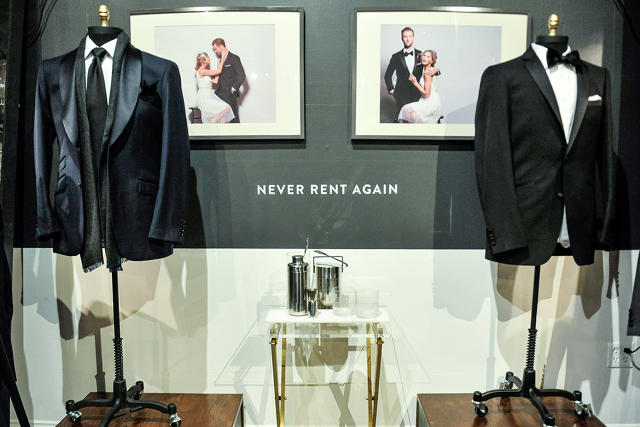by no means rent an ugly Tux again: These Startups need to Disrupt males’s Wearhouse
The Black Tux and Combatant gents are looking to drag males’s suiting into the 21st century. do we ultimately say goodbye to frumpy tuxes?
February 4, 2015
to hear males describe it, renting a tuxedo the old school manner is hell. When Patrick Coyne went to men’s Wearhouse to get a tuxedo for his pal Andrew Blackmon‘s Santa Barbara marriage ceremony, he used to be astounded through the method. “Some man measured me and used to be like, ‘You’re excellent to move,'” he defined. “Do I try anything else on?” the 25-year-old business school grad asked. it sounds as if now not. the primary time he donned his groomsman apparel used to be the day of the marriage, and albeit, the $250 outfit seemed horrific. “I gave the look of an fool,” he mentioned.
“we glance back on the pictures and it used to be 10 guys swimming in tuxedos,” added Blackmon, who used to be working in startups on the time. no longer that he was once stunned. “it is common information whilst you employ for prom or a wedding that you’re simply gonna appear humorous.” At this level, Blackmon used to be realizing he had the germ of an idea for startup of his own.
After Blackmon’s marriage ceremony fiasco, he and Coyne started The Black Tux, which final week secured $10 million in funding. The Black Tux works like appoint the Runway for menswear, and is certainly one of a growing cadre of direct-to-client, online native shops that purpose to elevate the experience of buying or renting an reasonably priced suit, tux, or associated accessory.

very similar to Warby Parker, these corporations personal as much of the production, design, logistics, and manufacturing course of as imaginable. without the overhead of lots of or hundreds of brick and mortar retailers and middlemen taking a reduce at each step of the way, these startups purpose to deliver an reasonably priced suit that does not look like a beige sack.
The Black Tux retains it easy. It deals five basic types: three tuxedos and two fits, renting every one out a regular 15 times sooner than retiring it. (Blackmon claims that males’s Wearhouse rents the the same garment forty to eighty occasions; males’s Wearhouse declined to remark for this text.) Tux condo takes only some clicks. After selecting a method, customers enter their measurements. for those who do not know, the website online has an educational system to assist renters measure their own lengths and widths. The outfit, including any further trappings like gown shirts, bow ties, cuff hyperlinks, and shoes, arrives per week ahead of the adventure. If one thing would not fit proper, simply send it back for something in a distinct size. to come, just pop in the mail the use of a pay as you go label.
There are also new options for males looking to buy affordable fits somewhat than hire—and have been additionally impressed through the despair skilled at men’s Wearhouse. “I stroll in there and really feel just dejected by way of existence,” says Vishaal Melwani, a 3rd-era tailor who desires to revamp the swimsuit-shopping for business for a youthful technology with his suit startup Combatant gentlemen. (professional reviewers agree: “buying there is a activity you wouldn’t wish upon your worst enemy since the suits had been terrible, the fabrics have been terrible, and it equated the act of buying a suit with all of the sophistication of buying an evening robe from a gown Barn,” starts offevolved Jian Deleon in his evaluate of the shopping expertise on complex. “The millennial in me wasn’t simply in search of a swimsuit, but in addition an expertise.”)

Combatant gentlemen, in the meantime, sells 100% wool fits for $160 the usage of what it calls a “sheep to wool” version. “We own sixty seven sheep,” mentioned Melwani, who based the corporate just after the recession when he noticed his simply-out-of-faculty pals shopping for interview acceptable clothing on a finances. Combatant gents additionally vegetation its personal cotton and Melwani, a skilled tailor, sews all the patterns. (Melwani’s household operates Versace boutiques alongside the West Coast.) The buying course of works loads like the Black Tux’s. for those who don’t know their size, “fit tech” helps with measurements. The garment comes within the mail quickly after; if it does not look just right, just send it again, free of charge.
whereas the nice experience attracts shoppers, high quality and price hooks them. “numerous guys have been skeptical early on,” stated Melwani. “For them to get a high quality go well with at $a hundred and sixty was once like, ‘k, where is the trap here?'” When the suit comes, it appears to be like and looks like Hugo Boss or J. Crew caliber, at males’s Wearhouse costs. individuals like that: just two years in, the corporate has broken $10 million in revenue. the corporate has attracted an outstanding roster of investors together with Zappos CEO Tony Hsieh and the Trunk membership CEO and Bonobos founder Brian Spaly, to call a couple. About 40% of Combatant gents’s purchasers are ex-men’s Wearhouse or Jos. A. bank guys.
owning or tightly controlling production and manufacturing provides these firms a leg up over the old-faculty competition. males’s Wearhouse has quite a lot of middlemen: an expensive, full fledged design crew, a trading firm that does the sourcing and manufacturing, after which it has the nasty overhead of 1,seven-hundred retail shops and all of the workers who work on the locations.

The Black Tuxes and Combatant gents of the world cut out as much of that as imaginable, and pass on lots of the financial savings to the shopper, which is how they get prices so low with out peddling ill-fitting type disasters. “one of the actual values is which you can deliver nice design at great prices. i will actually disintermediate with a wow,” mentioned Michael Alter, CEO of The Tie Bar, some other vertically built-in men’s retailer that sells the whole thing but the suit. on account of the “inherently loopy margins built into the business,” mentioned Coyne, “our business variation is successful sufficient to be attractive.”
“it’s like a Wild West when you find yourself attempting to determine what material mill to use, who will do the lower and sew—everybody wants to promote you and say they are going to make a suit and tux for $50, but then it’s the worst high quality,” defined Blackmon. “simply finding the individuals who had the highest quality used to be difficult.” The Black Tux uses an Italian mill, Tollegno for materials, and the same factories as Burberry and other high-finish swimsuit producers. males’s Journal has given The Black Tux its fashion stamp of approval. All Merino wool duds begin at simply $95 and moderate $a hundred and fifty per seem, and The Black Tux has seen double-digit sales growth each month on the grounds that launch.
Going after males’s Wearhouse isn’t any small purpose. The mega-retailer continues to be extremely dominant, with $3.5 billion in sales each and every yr. It also has a full-courtroom press on non-casual male apparel, not best catering to weddings, but promenade, bar-mitzvahs, job interviews, and any and all suiting wants. When people think low-cost swimsuit or tux, they think males’s Wearhouse. And but, regardless of hiring menswear fashion designer Joseph Abboud, firing founder George Zimmer, and acquiring Jos. A. bank, a talk over with to males’s Wearhouse is still sorely lacking (in retailer or on-line).
With extra direct-to-client choices than ever—Everlane, Bonobos, and Frank and Oak, to call a couple of—consumer habits and expectations are changing. males’s Wearhouse’s digital choices quantity to a few hashtags. Even the website online is troublesome to parse. After “constructing” a look, it’s unattainable to seek out how so much anything costs, and renting in some way requires printing out a type and physically bringing it to a brick-and-mortar location.
For now, that is still working for them: “males’s Wearhouse has 87% gross margins on their tux condominium trade. it is nice for them,” stated Coyne. “however, it is in point of fact bad for the consumer.”
(212)














